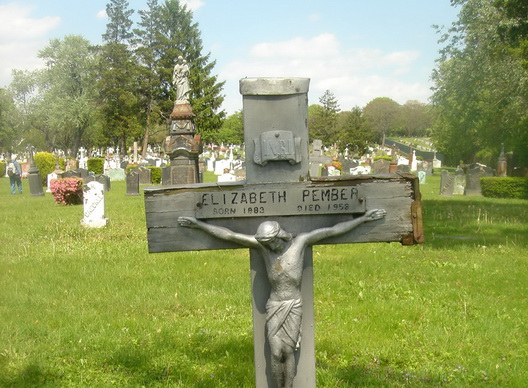Passengers on the L train speeding through Williamsburg and Bushwick seldom stop to think about one of the most unique and little known cemeteries in New York as they pass by. But if you look out the window at Wilson Avenue before reaching Broadway Junction, there it is. Close to the train tracks, with the Cemetery of the Evergreens to the east, sits Most Holy Trinity Cemetery for the curious to explore. Although it is located on a cul de sac at the juncture of Chauncey Street and Central Avenue, most people couldn’t find the 25-acre cemetery if they had directions. But it is well worth the sleuthing to get there.
The original cemetery was located behind Most Holy Trinity Church in Williamsburg, Brooklyn. When Father John Raffeiner, a pioneer priest among German Catholics in the City, made plans to build a new church on the property, the cemetery was moved and the remains from the original burial ground were transferred to the new site—which opened in October, 1851. What makes this cemetery so unique are the markers. To ensure uniformity and humility so that there would be no difference between rich and poor, a rule was passed that all markers would have to be made of wood or hollow metal (see wood grave marker picture).
Many of the early graves have crosses of different shapes, sizes and styles, most of them crucifixes. A newspaper account in the early 20th century referred to Most Holy Trinity as “this extraordinary spectacle of a multiplied Golgotha” and we couldn’t agree more. The Center was introduced to this mot unusual place on one of our walk tours of Bushwick, led by Adam Schwartz, last spring. It is a powerful place. The hollow metal monuments vibrated eerily in the wind. Even in the sunshine, the atmosphere reminds one of the graveyards in Eastern Europe depicted in old horror movies of the thirties. Indeed, many of the names on the monuments are eastern European, along with the original German parishioners.
After Father Raffeiner’s death, Father Michael May succeeded him as pastor and expanded the cemetery by purchasing an additional 21 acres from the Cemetery of the Evergreens. The original restrictions on monuments have been lifted and more modern graves are marked in stone, simple and laid in the ground. The names of the deceased have also begun to change, reflecting the changing ethnicities of the surrounding neighborhoods. The one person of some fame that we could find buried here is Philip Barry (1896-1949), the author best remembered for his plays, the most famous being “The Philadelphia Story” and “Holiday.”
—Ruth Edebohls
(Ruth Edebohls is the Coordinator of Urban Tours at the Center for the Urban Environment. To learn more about the Center visit us at www.bcue.org.)


1 response so far ↓
1 steve // Aug 13, 2008 at 10:14 am
Was this aka the tin cemetery?